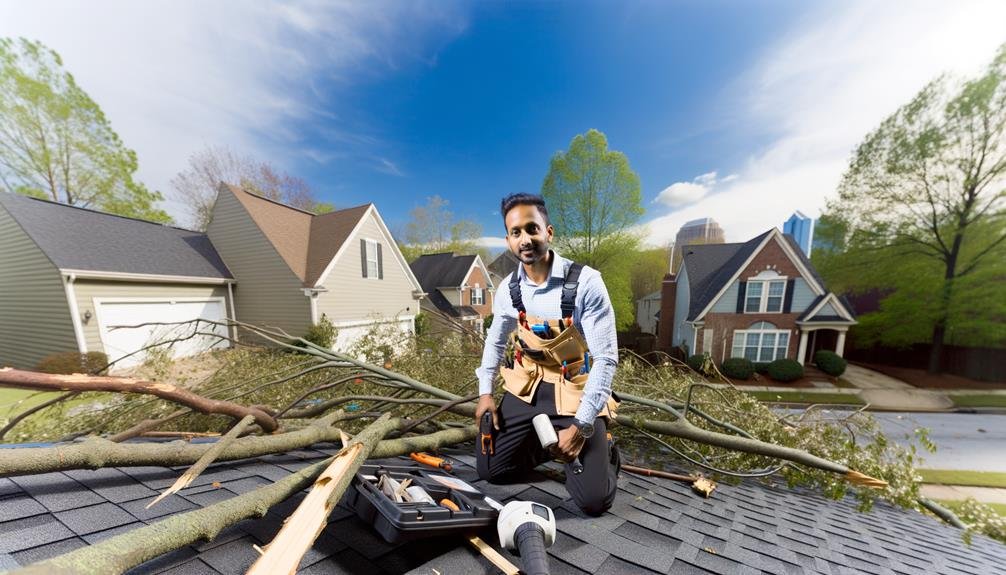When you face storm damage in Atlanta, it's essential to hire trustworthy and experienced professionals. They'll assess the damage quickly and accurately, identifying issues like missing shingles or water intrusion. Professionals use specialized tools to spot hidden problems you might overlook, ensuring your repairs are thorough and meet local building codes. They'll guide you through the insurance claims process, documenting the damage effectively. Choose contractors with solid qualifications and communication skills for a smoother experience. You'll gain peace of mind knowing your property is in capable hands, and there's more helpful information that can assist you in making prudent choices.
Understanding Storm Damage
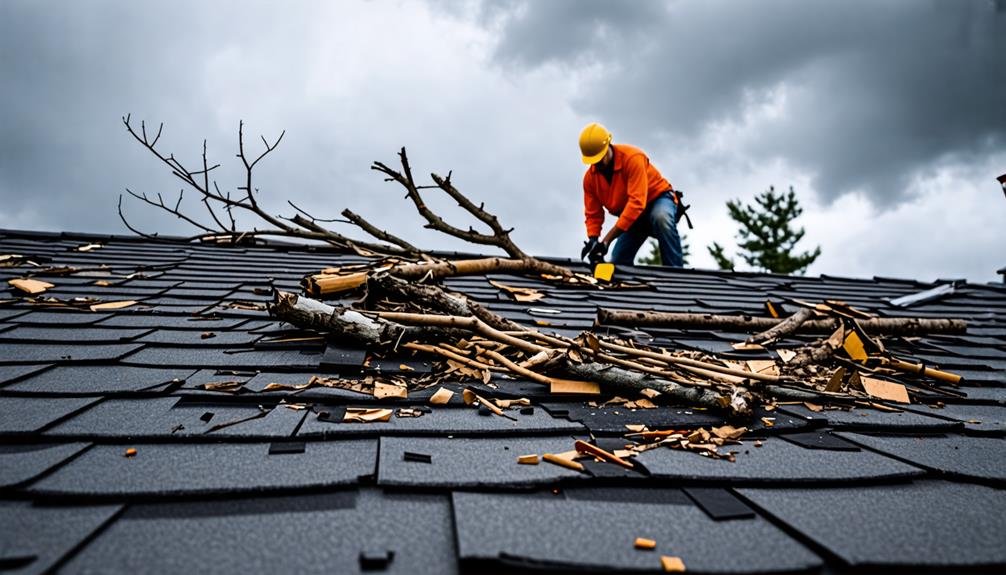
When storms hit Atlanta, they can cause considerable damage to your property, whether it's from high winds, heavy rain, or hail. Understanding storm severity is vital for you to assess the potential risks to your home. High winds can tear off roofing materials, while heavy rains may lead to flooding and water intrusion, compromising your structure's integrity. Hail can create dents and cracks in siding, windows, and roofs, which may not be immediately visible but can lead to bigger issues down the line.
As a homeowner, it's fundamental to know how your insurance coverage responds to storm damage. Policies vary greatly, so reviewing yours will help you understand what types of damage are covered and the extent of your financial protection. If a severe storm results in substantial damage, you'll want to file your claim promptly to guarantee you receive the necessary funds for repairs.
Signs You Need Repair
After a storm, it's important to look for specific signs that indicate your property may need repairs, as even minor damage can escalate if left unaddressed. Start by inspecting your roof; look for missing shingles, visible sagging, or any debris buildup. These could lead to roof leaks, which might not be immediately apparent but can cause significant problems over time.
Next, check your walls and ceilings for water stains or peeling paint, as these may signal hidden leaks. If you notice any musty odors, it could indicate mold growth, often a result of unnoticed flood damage. Don't forget to examine your gutters and downspouts; clogged or damaged gutters can lead to water pooling, increasing the risk of foundation issues.
Importance of Professional Help
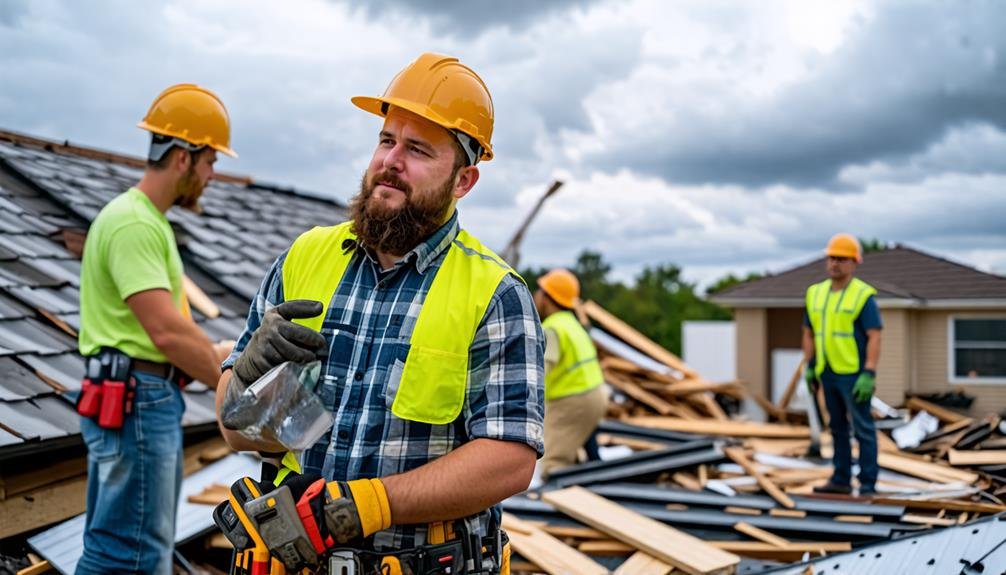
Hiring a professional for storm damage repair guarantees that all issues, from hidden leaks to structural vulnerabilities, are accurately assessed and effectively addressed. You might think about tackling repairs on your own, but without the right expertise, risks abound. Professionals bring not only their experience but also advanced tools to diagnose and fix problems that you might overlook.
Moreover, working with experts improves your emergency preparedness. They can provide valuable advice on how to safeguard your property against future storms and make sure that your repairs meet local building codes. This knowledge is crucial for maintaining the integrity of your home in the long run.
Additionally, professional help often simplifies the process of filing insurance claims. They know the ins and outs of insurance coverage and can assist you in documenting damages accurately. This not only speeds up the claims process but likewise increases your chances of receiving the compensation you deserve.
In the aftermath of a storm, choosing to hire professionals means you're investing in your peace of mind, making certain that your home is restored correctly and efficiently while protecting your financial interests.
Choosing the Right Contractor
Selecting the right contractor for storm damage repair requires careful consideration of their qualifications, experience, and reputation in the community. Start by researching the contractor qualifications necessary for your specific repairs. Look for licenses, certifications, and insurance coverage to guarantee they meet industry standards. A qualified contractor will not only have the technical skills but likewise the necessary credentials to protect you from liability.
Next, evaluate their experience. Ask for references and examples of past work, especially projects similar to yours. This will give you insight into their ability to handle your repair needs effectively.
Don't underestimate the importance of contractor communication. A reliable contractor should be responsive, approachable, and transparent about the repair process and costs. During your initial consultations, gauge how well they listen to your concerns and answer your questions. Effective communication nurtures trust and assures that you're on the same page throughout the project.
The Repair Process Explained
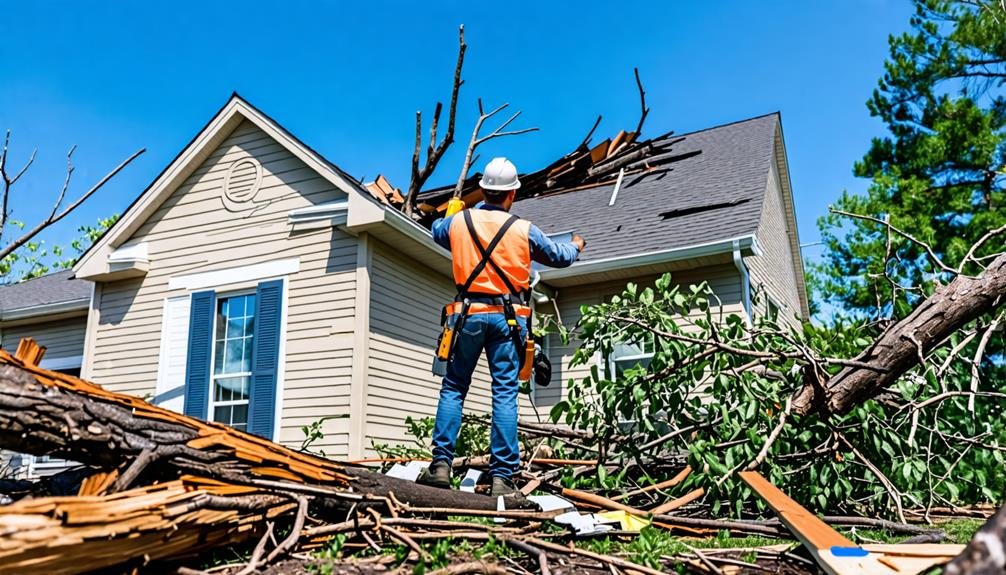
Understanding the repair process is essential for effective storm damage restoration. You'll start with an initial damage assessment to identify all affected areas, followed by developing a tailored repair plan. Finally, a quality inspection guarantees everything meets your standards before completion.
Initial Damage Assessment
After a storm, conducting a thorough damage assessment is crucial to identify the extent of the repairs needed for your property. You'll want to utilize effective damage evaluation techniques to guarantee nothing goes overlooked. Start by inspecting both the interior and exterior of your home. Look for visible signs of damage, such as broken windows, roof leaks, or compromised walls.
To help you organize your findings, consider using the following table for storm damage documentation:
| Damage Type | Location | Severity |
|---|---|---|
| Roof Damage | Roof | Severe |
| Window Breakage | Living Room | Moderate |
| Water Intrusion | Basement | Major |
| Siding Damage | Front of House | Minor |
| Tree Fall | Backyard | Severe |
Keep detailed notes and photographs to support your insurance claims. Once you've documented everything, you'll have a clear picture of what needs to be repaired. This initial damage assessment sets the stage for a successful recovery process, guaranteeing your home returns to its pre-storm condition.
Repair Plan Development
To effectively restore your home, you'll need to develop an all-encompassing repair plan that outlines each step of the recovery process. Start by creating a solid repair strategy that addresses the specific damage your home has sustained. This strategy should prioritize tasks based on urgency and importance, ensuring that you tackle the most critical repairs first.
Next, establish a project timeline that outlines when each phase of the repairs will take place. This timeline should be realistic and consider potential delays caused by weather or material availability. Break down the timeline into manageable milestones, so you can monitor progress and adjust as necessary.
Furthermore, communicate openly with your repair team. Keep them informed about any changes in your needs or expectations, and encourage them to provide feedback on the repair strategy. This collaborative approach not only cultivates trust but likewise helps keep the project on track.
Final Quality Inspection
Once your repair plan is in motion and substantial work is completed, conducting a final quality inspection becomes crucial to confirm that every aspect of the repair meets your expectations and adheres to safety standards. This inspection is your opportunity to verify quality assurance for the repairs made and identify any areas that may need adjustments.
During the final quality inspection, you'll want to carefully evaluate the work done, checking for proper installation, alignment, and overall finish. Pay attention to details like paint consistency, roofing integrity, and structural soundness. This isn't just about aesthetics; it's about making certain your home is safe and secure.
After this thorough examination, you may want to conduct a post-repair evaluation with your contractor. This collaborative discussion allows you to address any concerns or questions you might have. If everything checks out, you can confidently reclaim your space, knowing that the repairs were executed to the highest standards. Remember, the goal is to ascertain that your home not only looks great but is likewise well-protected against future storms. Trust the process, and enjoy the peace of mind that comes with a job well done.
Preventative Measures for Future Storms
How can you effectively safeguard your property against future storms? First, focus on storm preparedness by evaluating your home's vulnerabilities. Check your roof for loose shingles and verify gutters are clear to prevent water buildup. Trim back any overhanging branches that could snap during high winds.
Next, consider reinforcing windows and doors with storm shutters or impact-resistant glass. These upgrades can greatly reduce the risk of damage.
Don't forget about your yard; secure outdoor furniture and decorations to minimize projectiles during a storm.
Lastly, review your home insurance policy. Confirm it covers storm-related damages and understand your deductibles. Having the right coverage gives you peace of mind, knowing that you're financially protected if disaster strikes.
Taking these steps not only improves your property's resilience but also empowers you to face the unpredictable nature of storms. You're not just reacting to storm damage; you're actively working to prevent it. With a proactive approach, you can enjoy the freedom of knowing you've done everything possible to protect your home.
Cost Factors to Consider
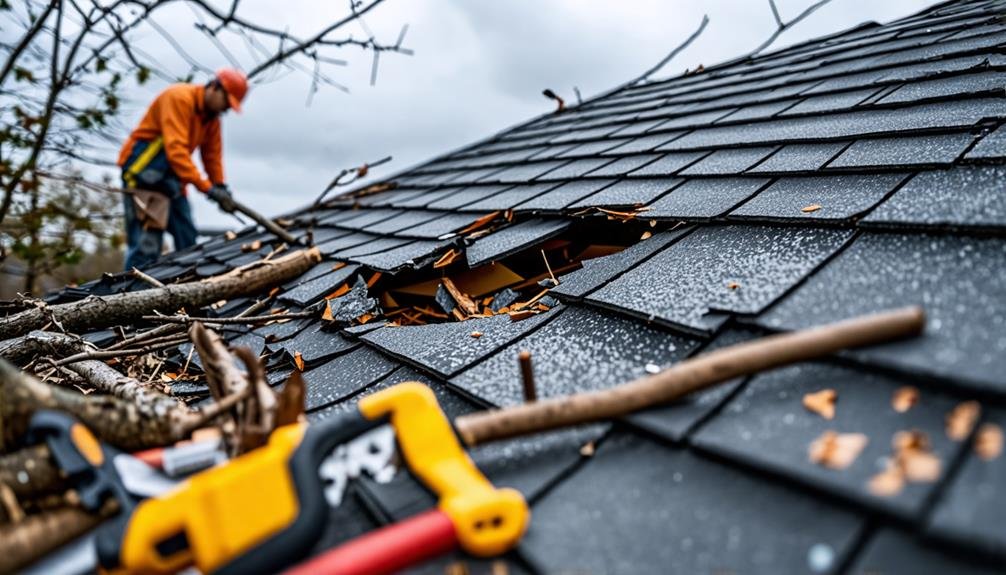
Understanding the cost factors involved in storm damage repair is vital for effective budgeting and planning. First, assess the extent of damage. Structural issues, roof repairs, and water damage can vary greatly in cost, so a thorough inspection is important.
Next, consider your insurance coverage. Many homeowners' policies cover storm damage, but the extent of coverage may differ. It's wise to review your policy and consult your insurance agent to determine what repairs are included. This could greatly reduce your out-of-pocket expenses.
Another factor to think about is repair financing. If your insurance coverage falls short or if you're facing high deductibles, exploring financing options can help ease the financial burden. Many repair companies offer flexible payment plans, allowing you to manage costs without feeling overwhelmed.
Additionally, remember to factor in permits and inspections, which can add to your total expenses. By understanding these cost factors, you'll be better equipped to make knowledgeable choices, ensuring your storm damage repair goes as smoothly as possible. Ultimately, being proactive in your financial planning will grant you the freedom to restore your home effectively.
Conclusion
When storm damage strikes, it's essential to act fast. By recognizing the signs early and seeking help from trustworthy professionals, you can safeguard your home. Think of it like patching a hole in a boat; if you wait too long, you risk sinking. Choosing the right contractor guarantees quality repairs and peace of mind. Plus, implementing preventative measures can protect you from future storms. Remember, a proactive approach today can save you headaches tomorrow.

